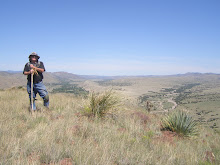Sunday, 30 August, 2009
I've just launched this blog, Hiking Apacheria, and want to welcome any of my previous readers, or any who are just arriving, to ask questions you may have about "Apacheria."
One of the essential features of Apacheria is the silence one encounters "out there, in Apacheria."
Whether you ascribe to the commonly held beliefs by most anthropologists and archaeologists that the Apache, as we know them, came into the areas we call Arizona and New Mexico, about the same time as the first major Spanish settlements did, along the Rio Grande, in the late 1500s, or earlier still, say, 1400-1500, Apacheria was for most of it's history, a very quiet place.
It's possible to walk all day out here, in SW New Mexico, and not even hear birds, during the winter. As many birds evacuate further south during the winter, much of the area around Silver City, New Mexico, where I live, is quiet in the winter. But
the hottest summer days, the expanse of this country is so vast that one has to wonder: is there simply so much "open space" that even the birds are statistically, few and far between?
I'd have to say, "yes," that makes sense to me; having hiked SW New Mexico now for seven years, I've been places where the birds seem like lonely sojourner, isolated in their treks across the country. There are times when not even the sounds of the modern world, such as jets flying overhead at many thousands of feet, break the silence.
So, I'd suggest that all those walkers, those hikers, came into a country undisturbed by a single extraneous sound. No machine noises; not human voices amplified by electronics; no motors; no cannons or fire arms booming. The sounds of other Native Peoples who came here were not raucous and rambunctious, I suspect. They were muted, I'm sure.
I can imagine the sounds of singing and drumming, for sure.
But even those sounds are absorbed by the vast spaces of silence.
I've been places where a conversation can be heard from fifty or a hunred feet away, when
cañon walls amplify the voices.
So, one of the more sublime experiences of "Hiking Apacheria," is the silence one can experience, particularly, when hiking alone.
It's the experience of Apacheria, (not just reading or writing about Apacheria, or watching a movie about the Apache), that I love.
Once one understands that time and space stretch away infinitely, and that the period of human intrusion with things that make noises is relatively brief, here in the Soutwest, then one must come to grip with the notion that for most of it's history, Apacheria has been quiet.
That's the first message from "Hiking Apacheria," today.
Labels: Hiking Apacheria; Apacheria; Silence; Spaces; Experience

